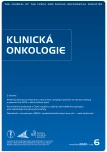Multiresistent opportunistic talaromycosis in a patient with ovarian cancer
Authors:
Lucia Fedorková 1,2; Ivan Vojtech 3; Lýdia Pianska He 1; Dalibor Ondruš 1
Authors‘ workplace:
I. onkologická klinika LF UK a OÚSA, Bratislava, Slovenská republika
1; Interná klinika VŠZaSP sv. Alžbety a OÚSA, Bratislava, Slovenská republika
2; Infektologická konziliárna ambulancia OÚSA, Bratislava, Slovenská republika
3
Published in:
Klin Onkol 2020; 33(6): 464-466
Category:
Case Report
Overview
Background: Talaromycosis (penicillinosis) is multiresistent opportunistic mycosis. The infection can be inapparent and it can simmulate malignant tumor dissemination in some patients. Case: We present a case of 33-years-old patient with mucinous adenocarcinoma of left ovary, initially FIGO IIC. The patient had had hysterectomy, bilateral adnexectomy, omentectomy and port-site metastasis extirpation. Six cycles of 1st chemotherapy paclitaxel and carboplatin had been administered to patient following the surgery. Positron emission tomography / computed tomography (PET/CT) scan after the treatment, had shown metabolic activity infiltrating both lung apexes, supposedly with no disease correlation, and hypermetabolic foci in spleen, suspicious of being metastases. Pacient showed no clinical symptoms, nor markers of inflammation elevation. Initially elevated serum tumor markers CA125 and CA72-4 had decreased after the treatment. Bronchoalveolar lavage cytology described presence of inflammatory infiltration with fungiforming hyphae – most probably an aspergillosis. Mannan and galactomannan serology was negative. In regard to splenectomy plans, treatment with voriconazol was initiated empirically. Result of fungi cultivation out of bronchoalveolar lavage was finalized later, showing sporadic presence o Penicillium sp. with resistance to antimycotic treatment except for amphotericin B. Liposomal amphotericin B treatment was administered in two cures, 28 days in total. Immunomodulatory treatment of secondary cellular immunodeficiency and vaccination against encapsulated bacteria was given to the patient. Splenectomy was performed 6 months after the end of chemotherapy treatment. Histopathology showed chronic granulomatous inflammation without mycotic hyphae, with no evidence of tumor cells. After the splenectomy, patient was treated by surgical incision and drainage and by klindamycin for intraabdominal abscess in left hypogastric area. Conclusion: Patient is under follow up by oncologist, immunologist and gynecologist 12 months after the splenectomy, she is surveilled by PET/CT and serum tumor markers. Talaromycosis can be clinically inapparent in spite of its dissemination. It can be present in diffuse, granulomatous and mixed form. Therapeutic agent is sometimes limited to amphotericin B due to its resistence. Liposomal form of amphotericin B is recommended regarding its pharmacokinetic properties. In case of dissemination, administration period of more than 14 days is recommended, even in inapparent form. Immunomodulatory treatment is recommended due to opportunistic infection.
Keywords:
talaromycosis – opportunistic infection – amphotericin B
Sources
1. Supparatpinyo K, Khamwan C, Baosoung V et al. Disseminated Penicillium marneffei infection in southeast Asia. Lancet 1994; 344 (8915): 110–113. doi: 10.1016/s0140-6736 (94) 91287-4.
2. Yousukh A, Jutavijittum P, Pisetpongsa P et al. Clinicopathologic study of hepatic Penicillium marneffei in Northern Thailand. Arch Pathol Lab Med 2004; 128 (2): 191–194. doi: 10.1043/1543-2165 (2004) 128<191: CSOHPM>2.0.CO; 2.
3. Cheng NC, Wong WW, Fung CP et al. Unusual pulmonary manifestations of disseminated Penicillium marneffei infection in three AIDS patients. Med Mycol 1998; 36 (6): 429–432.
4. Tong AC, Wong M, Smith NJ. Penicillium marneffei infection presenting as oral ulcerations in a patient infected with human immunodeficiency virus. J Oral Maxillofac Surg 2001; 59 (8): 953–956. doi: 10.1053/joms.2001.25881.
5. Leung R, Sung JY, Chow J et al. Unusual cause of fever and diarrhea in a patient with AIDS. Penicillium marneffei infection. Dig Dis Sci 1996; 41 (6): 1212–1215. doi: 10.1007/bf02088239.
6. Le T, Huu Chi N, Kim Cuc NT et al. AIDS-associated Penicillium marneffei infection of the central nervous system. Clin Infect Dis 2010; 51 (12): 1458–1462. doi: 10.1086/657400.
7. Louthrenoo W, Thamprasert K, Sirisanthana T. Osteoarticular penicilliosis marneffei. A report of eight cases and review of the literature. Br J Rheumatol 1994; 33 (12): 1145–1150. doi: 10.1093/rheumatology/33.12.1145.
8. Wong-Beringer A, Jacobs RA, Guglielmo BJ. Lipid formulations of amphotericin B: Clinical efficacy and toxicities. Clin Infect Dis, 1998; 27 (3): 603–618. doi: 10.1086/514704.
9. Chan JF, Lau SK, Yuen KY et al. Talaromyces (Penicillium) marneffei infection in non-HIV-infected patients. Emerg Microbes Infect 2016; 5: e19. doi: 10.1038/emi.2016.18.
10. Kawila R, Chaiwarith R, Supparatpinyo K. Clinical and laboratory characteristics of penicilliosis marneffei among patients with and without HIV infection in Northern Thailand: a retrospective study. BMC Infect Dis 2013, 13: 464. doi: 10.1186/1471-2334-13-464.
11. Zhang J, Huang X, Zhang X et al. Coinfection of disseminated Talaromyces marneffei and Mycobacteria kansasii in a patient with papillary thyroid cancer: a case report. Medicine (Baltimore) 2017; 96 (52): e9072. doi: 10.1097/MD.0000000000009072.
Labels
Paediatric clinical oncology Surgery Clinical oncologyArticle was published in
Clinical Oncology

Most read in this issue
- Immunostimulatory and anticancer effect of Reishi and Coriol extracts at the level of clinical studies and their implementation in practice
- First experience in the Czech Republic with perirectal hydrogel injection before radiotherapy for prostate cancer
- Stomatitis in mTOR inhibitors treatment and other targeted cancer therapy, possibilities of infl uencing it, and the use of local corticotherapy
- Treatment opinion of rehabilitation in sarcopenia and cachexia for oncological patients
